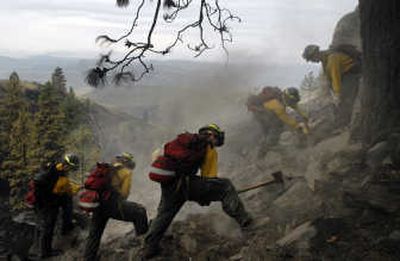Storm starts, douses blazes

The same thunderstorm system doused some wildfires and sparked others by the time it rolled through the Inland Northwest early Wednesday.
Lightning zapped north-central Idaho on Tuesday night, starting several small fires in the Clearwater and Nez Perce national forests, a Nez Perce forest news release states.
But the system also brought some relief. More than a half-inch of rain Wednesday morning helped about 400 people fighting the 16,500-acre Tunk Grade fire south of Tonasket, said Roland Emetaz of Washington Incident Management Team 5. By Wednesday evening, the lightning-caused fire had jumped from 15 percent to 80 percent contained, and command teams were demobilizing personnel – some of whom were sent to Okanogan County just days before.
“The rain really helped,” Emetaz said. “Before the rain came, though, we were planning on increasing the percentage of containment – but not this much.”
The Tunk Grade fire destroyed one home near Five Mile Road and six outbuildings and reached within hundreds of feet of Highway 20 at the blaze’s northern edge, Emetaz said.
At least a dozen large wildfires are burning in the Inland Northwest, and the National Weather Service has forecast more thunder and lightning today. While today’s weather should bring temperatures in the low 80s to the Spokane-Coeur d’Alene area, sun and sweltering heat should be back by Saturday.
Recent and predicted dry lightning has fire officials in Boise considering raising the nation’s wildfire preparedness from Level 4 to Level 5 – the highest intensity. That could mean international firefighting help or response by the National Guard as hot and dry conditions continue to pelt the West, the Associated Press reported.
In the northeast corner of Washington, the Windy Ridge Complex fire in the Colville National Forest has drawn more than 450 firefighters, but the blaze had burned just 340 acres by Wednesday evening, said Josie Williams, of Washington Incident Management Team 2.
“We don’t have a lot of air support, as we usually do,” she said. “So we’ve been a bit lighter on the aircraft, and we’re heavier on the ground crews.”
Since lightning sparked the fire Friday, crews have worked through hot temperatures, achieving 30 percent containment Wednesday, said Williams.
The area’s biggest wildfire, the 30,000 acre Chimney Complex blaze 19 miles south of Lewiston, was half-contained Wednesday as workers worked on its north and south edges, said Cameron Eck, of Kusicko/Cowin’s Type II Incident Management Team. Controlled burns and aerial drops countered moderate winds at the south end.
“We’ve had some sustained gusts,” he said. “It’s actually, for having wind, pretty manageable.”
But the recent storms barely grazed the area, only sprinkling the ground Tuesday as about 380 people helped battle the fire. Eck said crews are “cautiously optimistic” as they make their way closer to the July 28 predicted containment date.
Some firefighters are being sent home from the lightning-caused Horse Heaven Complex fires about 40 miles south of Prosser, said Dale Warriner, of Washington Incident Management Team 3. On Wednesday afternoon, crews fully contained the 28,600-acre fire, and fewer than 150 people were assigned to it by the evening.
The wildfire had destroyed several outbuildings but no homes, Warriner said.
Near St. Regis, Mont., seven fires totaling more than 90 acres were nearly half-contained Wednesday after lightning lit up the area Friday, according to a park ranger news release. A red-flag warning covered Western Montana and North Idaho on Wednesday night as severe thunderstorms brought high winds and hail.
While lightning has caused most of the region’s big blazes so far, the fire season is young. And human-caused wildfires are the ones that can be prevented, Williams said.
“It’s hot and dry, we’ve got a lot of season left, so people just need to really pay attention,” she said.